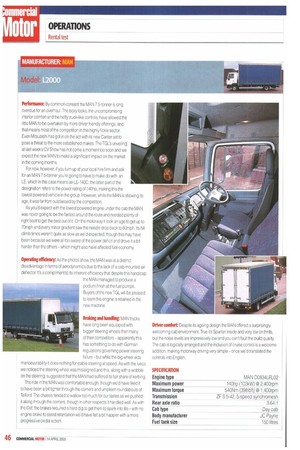Performance: By common consent the MAN 7.5-tanner is long overdue
Page 48

If you've noticed an error in this article please click here to report it so we can fix it.
for an overhaul. The boxy looks, the uncompromising interior comfort and the hefty truck-like controls, have allowed the little MAN to be overtaken by more driver friendly offerings, and that means most of the competition in this highly fickle sector. Even Mitsubishi has got in on the act with its new Canter set to pose a threat to the more established makes. The TGL's unveiling at last week's CV Show has not come a moment too soon and we expect the new MAN to make a significant impact on the market in the coming months.
For now, however, if you turn up at your local hire firm and ask for an MAN 7.5-tonner you're going to have to make do with an LE, which in this case means an LE-140C; the latter part of the • designation refers to the power rating of 140hp, making this the lowest powered vehicle in the group. However, while the MAN is showing its age, it was far from outclassed by the competition.
As you'd expect with the lowest powered engine under the cab the MAN was never going to be the fastest around the route and needed plenty of right boot to get the best out of it. On the motorway it took an age to get up to 70mph and every minor gradient saw the needle drop back to 60mph. Its hill climb times weren't quite as slow as we'd expected, though this may have been because we were all too aware of the power deficit and drove it a bit harder than the others which might also have affected fuel economy.
Operating effidency: As the photos show, the MAN was at a distinct disadvantage in terms of aerodynamics due to the lack of a cab-mounted air deflector. Its a compliment to its inherent efficiency that despite this handicap the MAN managed to produce a podium finish at the fuel pumps. Buyers of the new TGL will be pleased to learn this engine is retained in the new machine.
Braking and handing: MAN trucks have long been equipped with bigger steering wheels than many of their competitors apparently this has something to do with German regulations governing power steering failure but while the big wheel aids manoeuvrability it does nothing for stable steering at speed. As with the lveco we noticed the steering wheel was misaligned and this, along with a wobble on the steering, suggested that the MAN had suffered its fair share of kerbing.
The ride in the MAN was comfortable enough, though we'd have liked it to have been a bit tighter through the corners and umpteen roundabouts of Telford. The chassis tended to wallow too much for our tastes as we pushed it along through the corners, though in other respects it handled well. As with the Daf, the brakes required a hard dig to get them to spark into life with no engine brake to assist retardation we'd have felt a bit happier with a more progressive pedal action.
Driver comfort: Despite its ageing design the MAN offered a surprisingly welcoming cab environment. True it's Spartan inside and very Iowan thrills, but the noise levels are impressively low and you can't fault the build quality. The cab is logically arranged and the inclusion of cruise control is a welcome addition, making motorway driving very simple once we'd translated the controls into English.
SPECIFICATION Engine type MAN D0834LFL02
Maximum power 140hp (103kW) 21400rpm
Maximum torque 540Nm (398Ibft) 1,400rpm Transmission ZF S 5-42, 5-speed synchromesh Rear axle ratio 3.64:1 Cab type Day cab Body manufacturer JC Payne Fuel tank size 150 litres










































































































































































































